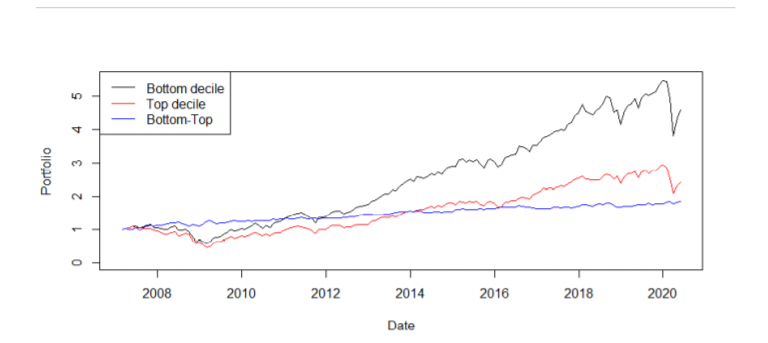We’ve already analyzed tens of thousands of financial research papers and identified more than 700 attractive trading systems together with hundreds of related academic papers.
Browse Strategies- Unlocked Screener & 300+ Advanced Charts
- 700+ uncommon trading strategy ideas
- New strategies on a bi-weekly basis
- 2000+ links to academic research papers
- 500+ out-of-sample backtests
- Design multi-factor multi-asset portfolios
Upgrade subscription
The alternative data, machine learning methods and textual analysis are modern trends in financial markets. Algorithms can process much more information than a human can do. A good example is 10-K & 10-Q company fillings. Those reports are getting longer, include more textual information and are harder to analyze. However, a textual analysis made by an algorithm can identify various patterns that can be utilized in financial practice.
A well-known example among the academic literature is the paper Lazy prices. Authors have found that stocks of firms that have changed the reports underperform compared to no-changers.
The Lazy prices studied changes (or similarity) of all language, but there is a possibility to go further. This novel research utilizes Brain Company`s datasets that identify various types of language: all, positive, negative, uncertainty, litigious, constraining and interesting language. It is shown that the similarity of positive language has different implication compared to the Lazy prices. The lowest positive similarity stocks outperform the highest positive similarity stocks, and the difference is approximately 5% yearly.
The practical implications are straightforward: its either possible to go long low similarity stocks or utilize the anomaly in the long-short approach where investor goes long low similarity stocks and short high similarity stocks. The data about both strategies are presented in the paper, but we centre our attention around the long-short approach. The strategy is not as profitable as the long-only implementation but has an impressive risk-adjusted return and very stable performance.
Fundamental reason
Firstly, there are major differences compared to Lazy prices. The presented paper is focused on the similarity of positive language only (compared to the similarity of all language), motivated by the search for the most profitable strategy. Additionally, the holding period is shorter (one month compared to three months), and stocks are sorted into deciles based on their most recent 10-K or 10-Q report. The strategy does not wait for the new quarter release, but rather use the most recent report. The last difference is the investment universe. Previous research has examined the effect on approximately 4000 stocks, which has to include smaller capitalization stocks and possible liquidity issues. The Brain analyzes company reports for approximately the largest 1000 US stocks. As a result, the investment universe includes mostly large caps with better liquidity and lower slippage costs and spreads.
The mechanism behind the functionality is foggy. The hypothesis of the paper is that the effort to change the positive language should positively influence subsequent returns because management does not have the motivation to change report if it would harm the company significantly. It should rather positively influence the potential investor.
Last but not least, results suggest that the low positive similarity effect is a distinct anomaly in the financial markets. There is an economically and statistically significant alpha, and also the change of sentiment extracted from filings cannot explain the positive similarity effect.
- Unlocked Screener & 300+ Advanced Charts
- 700+ uncommon trading strategy ideas
- New strategies on a bi-weekly basis
- 2000+ links to academic research papers
- 500+ out-of-sample backtests
- Design multi-factor multi-asset portfolios
Backtest period from source paper
2007-2020
Confidence in anomaly's validity
Strong
Indicative Performance
5.47%
Notes to Confidence in Anomaly's Validity
Notes to Indicative Performance
data from Table 2, Bottom-Top
Period of Rebalancing
Monthly
Estimated Volatility
6.48%
Notes to Period of Rebalancing
Notes to Estimated Volatility
data from Table 2, Bottom-Top
Number of Traded Instruments
637
Notes to Number of Traded Instruments
Stocks with large market cap covered by the Brain Company
Notes to Maximum drawdown
data from Table 2, Bottom-Top
Complexity Evaluation
Moderately complex strategy
Notes to Complexity Evaluation
Financial instruments
stocks
Simple trading strategy
The investment universe consists of stocks with large market cap covered by the Brain Company, for which stock prices were available to download from Yahoo Finance and had full history during the sample period. Firstly, only the similarity of the positive language is considered. The positive similarity score is calculated as the cosine similarity and is provided by the Brain Company. Each month, stocks are ranked based on the positive similarity language score of their most recent company filing and sorted into deciles. Long the bottom decile and short the top decile. The strategy is equally-weighted and rebalanced monthly.
Hedge for stocks during bear markets
Yes - The strategy is uncorrelated to the market factor and has consistent performance also during crises. Additionally, it has low drawdowns.
Out-of-sample strategy's implementation/validation in QuantConnect's framework
(chart+statistics+code)










